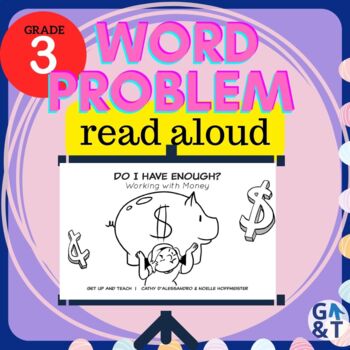Math Mindset Word Problem Read Aloud Gr. 3: Do I Have Enough?
Get Up and Teach
16 Followers
Grade Levels
2nd - 4th
Subjects
Standards
CCSS3.OA.D.8
CCSSCCRA.R.2
CCSSCCRA.R.3
CCSSCCRA.R.7
CCSSMP1
Formats Included
- Zip
Pages
63 pages
Get Up and Teach
16 Followers
Also included in
- How would you like to keep the focus on the importance of mindset in your grade 3 classroom all year long?These three comics will keep you discussing mindset all year long!This bundle includes:"Why Can't We Just Eat the Cookies?" focusing on 2 step word problems"Where Does the Time Go?" focusing onPrice $39.99Original Price $45.00Save $5.01
Description
What if you could teach math, reading, and social emotional learning all at once? Look no further: this is the book! As you read this comic to your students and ask the supporting questions, students will connect with the relatable characters in the text. In addition, students will have the opportunity to not only try the money word problem, but to dive deep into the question: does our attitude affect our performance? You'll begin a discussion about mathematical mindset and its importance! We've done all of the work FOR you! Just download, project, and read!
Total Pages
63 pages
Answer Key
Included
Teaching Duration
N/A
Report this resource to TPT
Reported resources will be reviewed by our team. Report this resource to let us know if this resource violates TPT’s content guidelines.
Standards
to see state-specific standards (only available in the US).
CCSS3.OA.D.8
Solve two-step word problems using the four operations. Represent these problems using equations with a letter standing for the unknown quantity. Assess the reasonableness of answers using mental computation and estimation strategies including rounding.
CCSSCCRA.R.2
Determine central ideas or themes of a text and analyze their development; summarize the key supporting details and ideas.
CCSSCCRA.R.3
Analyze how and why individuals, events, and ideas develop and interact over the course of a text.
CCSSCCRA.R.7
Integrate and evaluate content presented in diverse media and formats, including visually and quantitatively, as well as in words.
CCSSMP1
Make sense of problems and persevere in solving them. Mathematically proficient students start by explaining to themselves the meaning of a problem and looking for entry points to its solution. They analyze givens, constraints, relationships, and goals. They make conjectures about the form and meaning of the solution and plan a solution pathway rather than simply jumping into a solution attempt. They consider analogous problems, and try special cases and simpler forms of the original problem in order to gain insight into its solution. They monitor and evaluate their progress and change course if necessary. Older students might, depending on the context of the problem, transform algebraic expressions or change the viewing window on their graphing calculator to get the information they need. Mathematically proficient students can explain correspondences between equations, verbal descriptions, tables, and graphs or draw diagrams of important features and relationships, graph data, and search for regularity or trends. Younger students might rely on using concrete objects or pictures to help conceptualize and solve a problem. Mathematically proficient students check their answers to problems using a different method, and they continually ask themselves, "Does this make sense?" They can understand the approaches of others to solving complex problems and identify correspondences between different approaches.






